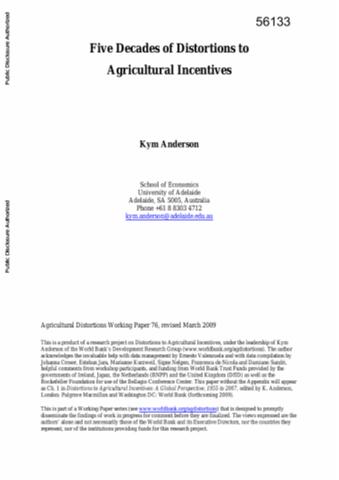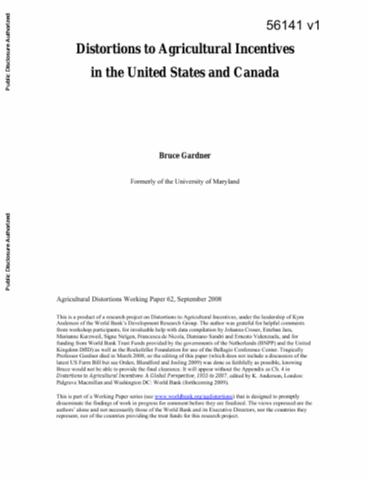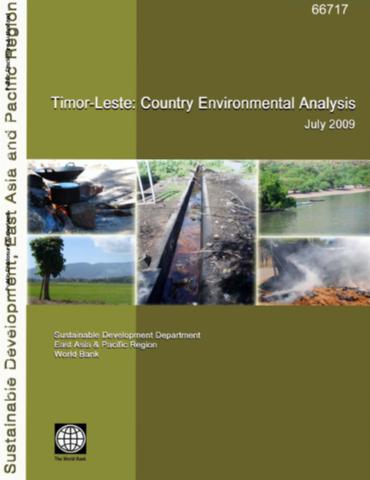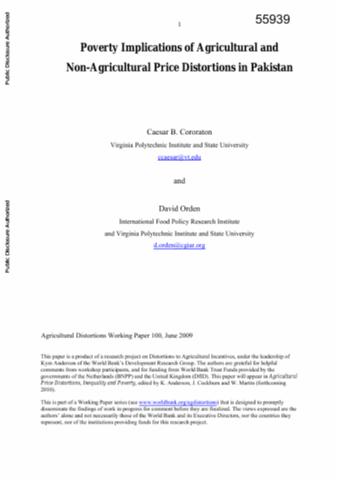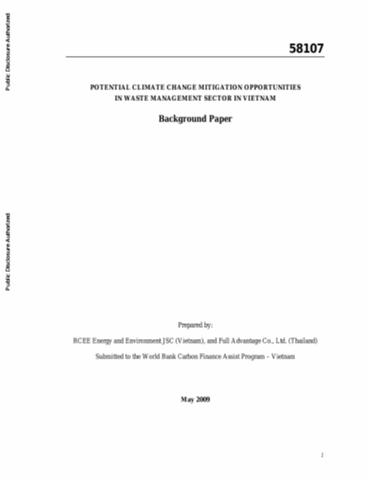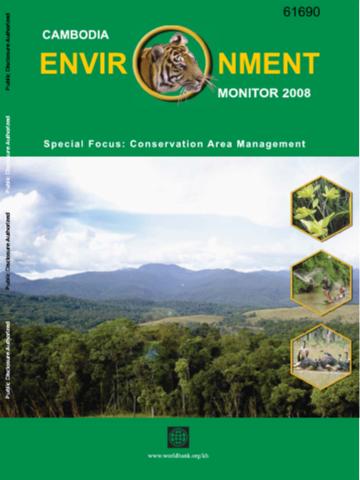
Topics and Regions
Details
Location
Contributions
Displaying 71 - 80 of 630Five Decades of Distortions to Agricultural Incentives
This chapter begins with a brief summary of the long history of national distortions to agricultural markets. It then outlines the methodology used to generate annual indicators of the extent of government interventions in markets, details of which are provided in Anderson and appendix A.
Welfare and Poverty Effects of Global Agricultural and Trade Policies Using the Linkage Model
This paper analyzes the economic effects of agricultural price and merchandise trade policies around the world as of 2004 on global markets, net farm incomes, and national and regional economic welfare and poverty, using the global economy wide Linkage model, new estimates of agricultural price distortions for developing countries, and poverty elasticity's approach. It addresses two questions: to what extent are policies as of 2004 still reducing rewards from farming in developing countries and thereby adding to inequality across countries in farm household incomes?
Improving the Business Environment in Latvia
This paper tracks the process through which FIAS, the investment climate advisory service of the World Bank Group advised the government of Latvia from 1998 to 2004 on ways to improve the business environment, achieve higher rates of economic growth, and thereby alleviate poverty. This case study shows that it is reasonable to describe how assistance by FIAS led to an improved business environment.
Distortions to Agricultural Incentives in Sub-Saharan and North Africa
This chapter begins with a brief summary of economic growth and structural changes in the region since the 1950s and of agricultural and other economic policy developments as they affected the farm sector at the time of and in various stages after independence from colonial powers.
Agricultural Activities, Water, and Gender in Tajikistan's Rural Sector
This social assessment (SA) was conducted under the Fergana Valley Water Resources Management Project (FVWRMP), which is providing assistance to the Government of Tajikistan to address irrigation and drainage deficiencies in Eastern Sughd. The main SA objectives were to understand how prevailing structures of water provision, land reforms, and gender relations impact rural livelihoods; to analyze experiences in establishing inclusive Water Users Associations (WUAs); and to provide recommendations to FVWRMP with the aim of enhancing its programs.
Distortions to Agricultural Incentives in the United States and Canada
There is much in common between the agricultural sectors of the United States and Canada. This chapter begins with a brief background on the two sectors, then reviews their histories of farm policy developments before reporting new estimates of rates of assistance to their farmers and their consequences for taxpayers and consumers. This is followed by an explanation of the politics behind the evolution and gyrations in farm policies in the two countries, and some speculation on the prospect for reform.
Timor-Leste
The Country Environmental Analysis (CEA) for Timor-Leste identifies environmental priorities through a systematic review of environmental issues in natural resources management and environmental health in the context of the country's economic development and environmental institutions. Lack of data has been the main limitation in presenting a more rigorous analysis. Nevertheless, the report builds on the best available secondary data, presents new data on the country's wealth composition, and derives new results on the costs of water and air pollution.
Poverty Implications of Agricultural and Non-Agricultural Price Distortions in Pakistan
Using recent estimates of industry assistance rates, the effects of trade liberalization in the rest of the world and in Pakistan alone are analyzed using a global and a Pakistan computable general equilibrium (CGE) model under two tax replacement schemes: a direct income tax and an indirect tax replacement. The results indicate that the distributional and poverty effects in Pakistan of a unilateral liberalization of all traded goods are significantly greater than the effects of trade liberalization in the rest of the world.
Potential Climate Change Mitigation Opportunities in Waste Management Sector in Vietnam
Along with economic growth and improved living standards, waste from households, industries, and commercial or service establishments is expected to increase rapidly over the next years. Managing this waste is a hard challenge for the Government of Vietnam because of its substantial cost and lack of awareness and participation of people and businesses. Wastes can be classified according to: their form (wastewater, solid waste); their origin (industrial wastes, agricultural wastes, urban (municipal) wastes); and their hazardous nature (non-hazardous or hazardous).
Cambodia Environment Monitor 2008
The Cambodia environment monitor 2008 is one of a series of environmental reports prepared for East Asian countries under an initiative sponsored by the World Bank. The objective of this series is to present a snapshot of environmental trends across a range of issues. The purpose of the monitor is to engage and inform interested stakeholders about key environmental changes in an easy to understand format accessible to a wide audience. This report identifies seven strategic priorities for the Royal government of Cambodia and its conservation partners.

